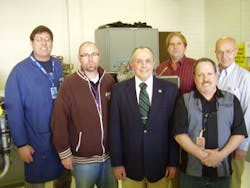State of AMTSociety Address
Passing the Wrench program
This program has been very well received, so much so, that we have a waiting list from schools that are in need of tools. If you know of an individual or a family who would like to donate a toolbox for this program, please contact director Ken MacTiernan at [email protected]. This is another way we can give back to the industry.
Workplace pressure — Don’t turn one emergency into two
Two wrongs don’t make a right, but three lefts do. How often are we pushed into making decisions in a hurry? Whether the aircraft is late for departure or the air ambulance crew is in a hurry to get to an automobile accident.
Something is broken (first wrong) and as a mechanic it is your job to make sure it gets repaired/fixed properly. You may be tempted to stick a piece of chewing gum on a leak and call it good until they get back (second wrong). While it may seem right at the time, the proper procedure would be to replace the seal (first left), test it (second left), and close out the paperwork (third left). If you let the aircraft go in less than in an airworthy condition, imagine the pressure you will feel when all those families want to know what happened. Pressure is one of the human factors’ Dirty Dozen. Don’t fall victim to pressure. To learn more about maintenance human factors, and all of the Dirty Dozen visit hfskyway.faa.gov/hfskyway/index.aspx.
Aviation safety begins on the ground and in the hangar. As an AMT you are an invisible member of the aviation safety team. Having the proper tools to do your job involves more than just filling your toolbox with nice shiny wrenches and screwdrivers. The FAA Safety Team (FAASTeam) is committed to helping you achieve the highest level of safety by providing tools and resources to enhance your knowledge and proficiency.
Airport surface deviations
Are you a maintenance technician or an airport employee who has to use vehicles or tugs on the airport movement area? Do you know what one of the major causes of runway incursions is? If you guessed vehicle/pedestrian deviation then you are correct.
Vehicle/pedestrian deviations are on the rise. This trend of airport vehicles, tenant vehicles, and pedestrians accessing the movement areas of an airport has increased significantly in recent months.
Whether you are an airport employee or a tenant, help stop the alarming trend by becoming familiar with the areas where vehicles and pedestrians have access to the secure side of the airport and be vigilant in policing those areas. See that warning signs are posted in a conspicuous place near all entrance points.
As an airport vehicle/tug operator you should be very familiar with the runway signage, markings, and two-way communication requirements. Utilize the Ground Vehicle Guide to Airport Signs and Markings placards available through your local FAASTeam program manager, lead representative, or the FAA Office of Runway Safety. Airport tenants need to also realize that vehicle operations on the movement area of any airport must conform to the same procedures. Two-way communications must be established and all ATC instructions must be followed in order to operate a vehicle on the movement area of the airport. Be especially observant for any “light gun signals” from the control tower and be sure to follow them also.
AMT Day
AMTSociety is working with NBAA and PAMA on the national establishment of May 24 as AMT Day in observance of Charles E. Taylor’s birthday. Richard Dilbeck, Ken MacTiernan, director of AMTA, and I have worked for nine years to get this accomplished. To date all but seven states have their own resolution already passed. Please take the time and send a letter to your Senator or Congressman requesting their support of this resolution. It is for the recognition of all of us n the aviation maintenance industry. Coverage of AMT Day activities will be in the next issue. Have a great summer.
Tom Hendershot
Master Instructor
In March Tom Hendershot was awarded Master Aviation Educator status by Master Instructors LLC. The accreditation is valid for 24 calendar months. The award involves education activities; continuing education; service to the aviation community; creation of media through newsletters, articles, and development of aviation seminars; and participating in organizations that promote aviation. JoAnn Hill, MCFI and Master Instructor Board of Review, stated, “Congratulations on your master Instructor designation. The professionalism and dedication you have show truly represent the crème de la crème of aviation education.”



